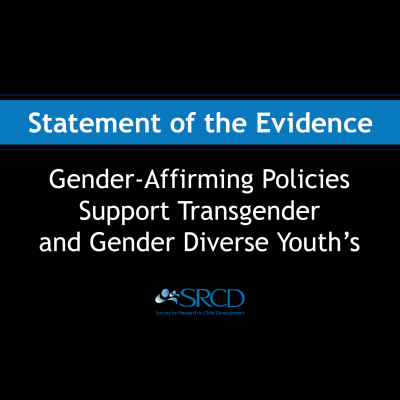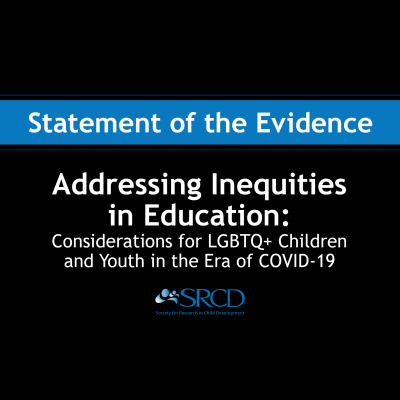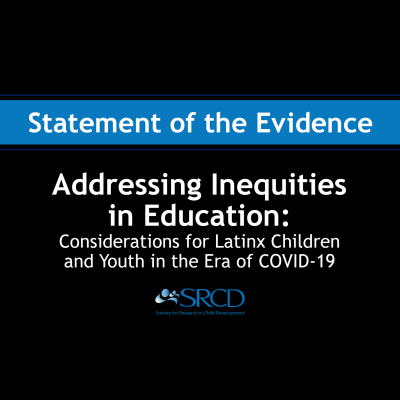Making Schools Safe for Sexual-Minority and All Students
Social Policy Report Brief, Volume 24, Issue 4
Why Does This Matter?
Youth who identify as part of a sexual minority—that is, those who identify as lesbian, gay, bisexual, transgender, queer and/or questioning—are vulnerable to bullying, harassment, compromised achievement, and emotional and behavioral health problems. A national survey of sexual-minority students in secondary schools found that nearly all of them heard homophobic remarks in school, and three-quarters heard such remarks often. Moreover, 40 percent had been physically harassed and 20 percent had been physically assaulted.
Safe-school laws that specify that sexual-minority students are protected can foster a safe school environment for all students.
Policy Implications
Federal and state policymakers should:
- Develop school safety laws that specifically enumerate, or list, sexual-minority students as protected. Safe-school laws address bullying and harassment in schools and can be more or less specific about which groups are protected. Federal and state laws can provide a foundation on which local policies can be based.
Local policymakers, school districts, and school officials should:
- Develop school safety policies that specifically indicate that sexual-minority students are protected from bullying and harassment.
- Train school personnel to address bullying and harassment, refrain from making homophobic comments, and intervene when comments or behaviors involve discrimination based on actual or perceived sexual orientation or gender identity.
- Inform all students of school policies that aim to prevent and respond to verbal or physical harassment, bullying, or victimization based on sexual orientation or gender identity, and provide students with information and resources on these issues.
What the Research Says
- Sexual-minority youth are at high risk of being bullied. In schools, these youth are victimized more than their peers.
- This victimization is associated with poorer mental health, including depression, anxiety, and sleep disturbances; with risky behaviors such as substance use and sexual risk-taking; and with poor academic achievement, attendance, and attitudes toward school.
- Students report that teachers intervene less when homophobic remarks are made than when racist or sexist remarks are made.
- Teacher intervention in harassment is particularly important: Students feel safer when they report that their teachers intervene to stop harassment.
- Sexual-minority students living in states with enumerated laws report less harassment and assault.
- School-level policies also matter. Students in schools with comprehensive and enumerated school safety policies report fewer suicide attempts.
- Whether or not they are sexual-minority students, youth in schools with comprehensive and enumerated school safety policies report feeling safer.
- The presence of curricula and school groups that address discrimination against sexual-minority students has been shown to contribute to students’ sense of school safety.
Facts at a Glance
- Youth today are identifying themselves as members of a sexual minority in larger numbers and at younger ages, with reported milestones of sexual identity development happening earlier than before.
- Two federal laws (H.R. 2262 & S. 3739, the Safe Schools Improvement Act; and H.R. 4530 & S. 3390, the Student Non-Discrimination Act) are currently under consideration in the United States that would provide explicit protection to sexualminority students in public schools.
- Currently, 16 states plus the District of Columbia prohibit discrimination or harassment in schools on the basis of sexual orientation. Most of these enumerated laws, many passed in the last five years, also include protections on the basis of gender identity and expression, including specific anti-bullying and nondiscrimination laws that apply to K-12 education.
- Thirty-three states have enacted school antibullying/anti-harassment laws that do not enumerate specific protections for any group of students, including sexual-minority students.
- Most adolescents distinguish between their beliefs and attitudes about homosexuality and their understanding of the fair treatment of others. While most teens (between 50 and 80 percent) do not approve of homosexuality, fewer than 5 percent say it’s acceptable to tease or harass someone because they are gay or lesbian.
This brief summarizes a longer Social Policy Report, "Safe Schools Policy for LGBTQ Students," by Stephen T. Russell, Distinguished Professor and Fitch Nesbitt Endowed Chair in Family Studies and Human Development at the University of Arizona; Joseph Kosciw, Senior Director of Research & Strategic Initiatives at the Gay, Lesbian and Straight Education Network; Stacey Horn, Associate Professor of Educational Psychology at the University of Illinois at Chicago; and Elizabeth Saewyc, Professor of Nursing and Adolescent Medicine at the University of British Columbia.


